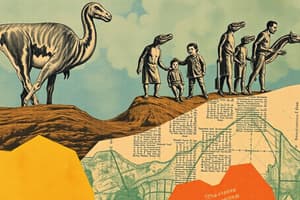Podcast
Questions and Answers
What is the process called when one tectonic plate is forced under another?
What is the process called when one tectonic plate is forced under another?
- Transform Faulting
- Divergence
- Faulting
- Subduction (correct)
Which type of seismic wave arrives first at a seismic recording station?
Which type of seismic wave arrives first at a seismic recording station?
- Secondary (S) wave
- Surface wave
- Tertiary wave
- Primary (P) wave (correct)
Which feature is formed at a divergent boundary?
Which feature is formed at a divergent boundary?
- Subduction Zone
- Transform Fault
- Mid-Ocean Ridge (correct)
- Volcanic Island Arc
What characterizes the Ring of Fire?
What characterizes the Ring of Fire?
What is the composition of continental crust compared to oceanic crust?
What is the composition of continental crust compared to oceanic crust?
Which of the following describes a hot spot?
Which of the following describes a hot spot?
What is the significance of the term Pangea in geology?
What is the significance of the term Pangea in geology?
Which mechanism is primarily responsible for the occurrence of earthquakes?
Which mechanism is primarily responsible for the occurrence of earthquakes?
Flashcards are hidden until you start studying
Study Notes
Geological Terms
- Convergent Boundary: Plates collide, allowing one to subduct beneath another, often resulting in mountain formation and volcanic activity.
- Crust: Earth's outermost layer, divided into continental and oceanic types, varying significantly in thickness and composition.
- Continental Crust: Thicker segment of the crust composed primarily of granite; extends across landmasses.
- Oceanic Crust: Thinner portion of the crust made mainly of basalt; occurs beneath oceans and is denser than continental crust.
- Divergent Boundary: Area where tectonic plates pull apart, leading to the formation of new crust as magma rises to the surface.
- Earthquake: Sudden shaking of the ground, caused by the release of energy from fault lines or volcanic activity.
- Fault: Fracture in Earth's crust where movement has occurred, essential for understanding earthquake dynamics.
- Hot Spot: Stationary area of intense heat in the mantle where magma can create volcanoes, independent of tectonic plate boundaries.
- Mid-Ocean Ridge: Underwater mountain range formed by plate tectonics, marking divergent boundaries and where new oceanic crust is created.
- Pangea: Ancient supercontinent that existed roughly 200 million years ago, later separated into today's continents, contributing to the development of plate tectonics.
- Plates: Rigid segments of the lithosphere that interact at their boundaries causing geological phenomena.
- Plate Tectonics: Scientific theory explaining the movement of Earth's plates and its implications for earthquakes, mountains, and volcanic eruptions.
- Primary (P) Wave: The fastest seismic waves, traveling through solids and liquids; the first waves recorded during an earthquake.
- Ring of Fire: Geologically active area surrounding the Pacific Ocean, known for its high incidence of earthquakes and volcanic activity.
- Rocks: Aggregates of minerals; classified into three main types: igneous, metamorphic, and sedimentary.
- Secondary (S) Wave: Seismic waves that follow P-waves, move only through solids, and cause more surface damage.
- Seismogram: The visual output recorded by a seismograph, showing the intensity and duration of seismic waves.
- Seismograph: Instrument used for detecting and recording the amplitude of seismic waves generated by earthquakes.
- Subduction: Process where one tectonic plate moves under another, contributing to volcanic activity and deep ocean trenches.
- Transform Fault Boundary: Occurs when plates slide past each other horizontally, leading to earthquakes without creating or destroying crust.
- Volcanic Island Arc: A series of volcanoes formed along a trench as a result of subduction, leading to island chains.
Studying That Suits You
Use AI to generate personalized quizzes and flashcards to suit your learning preferences.




